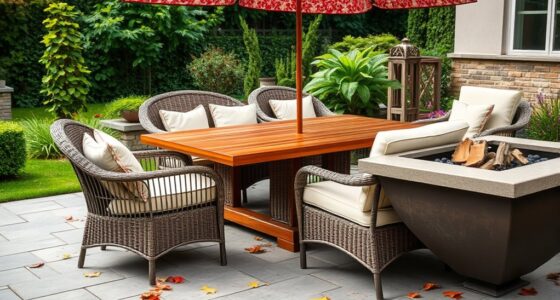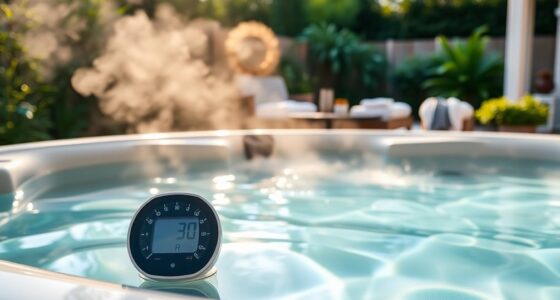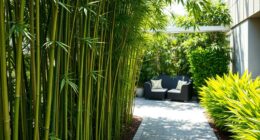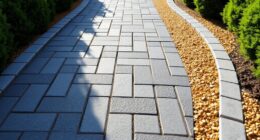To design a low-maintenance backyard, start by evaluating your soil and incorporating native plants that thrive in your area. Select drought-tolerant varieties and group plants by their watering needs. Use efficient irrigation systems and mulch to retain moisture. Incorporate durable hardscaping features like gravel paths and patios. Create spaces for wildlife with native plants and small water sources. For a fuller picture of easy-care landscaping techniques, you’ll want to explore further insights.
Key Takeaways
- Analyze soil conditions and select drought-tolerant native plants to reduce water needs and maintenance.
- Group plants by watering requirements to streamline irrigation and care efforts.
- Implement an efficient irrigation system and consider rainwater harvesting for sustainable water management.
- Utilize hardscaping elements like gravel pathways and durable materials to minimize lawn upkeep and maintenance.
- Incorporate features that support local wildlife, such as native plants, small ponds, and pollinator gardens for ecological balance.
Creating the Foundation
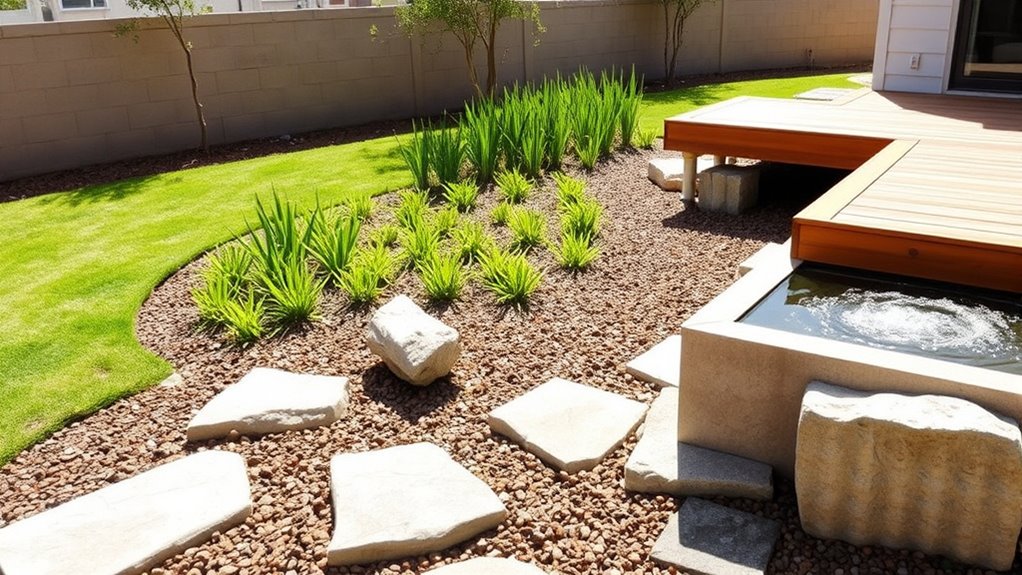
When you’re ready to create a low-maintenance backyard, the first step is analyzing your site to lay a solid foundation.
Start by testing your soil for pH levels and nutrient deficiencies; this helps determine what amendments you need. Document existing plants to see which ones you can incorporate into your new design. Additionally, consider adding native plants that require less water and care, as they are well-suited to your local environment. Furthermore, incorporating permaculture techniques can enhance soil health and reduce maintenance needs over time. One effective method is to use cover crops that can improve soil quality while suppressing weeds.
Next, assess structural elements like pathways and irrigation systems, ensuring they work with your layout. Understanding your local climate and sun exposure can also help inform your choices, especially when considering solar energy solutions for any outdoor lighting or power needs.
Finally, check drainage to prevent water accumulation that could damage your structures. Additionally, consider implementing long-term financial planning to ensure that you can maintain your garden without unnecessary stress. A solid foundation sets you up for success in designing a backyard that requires minimal upkeep while remaining functional and beautiful.
Selecting Low-Maintenance Plants
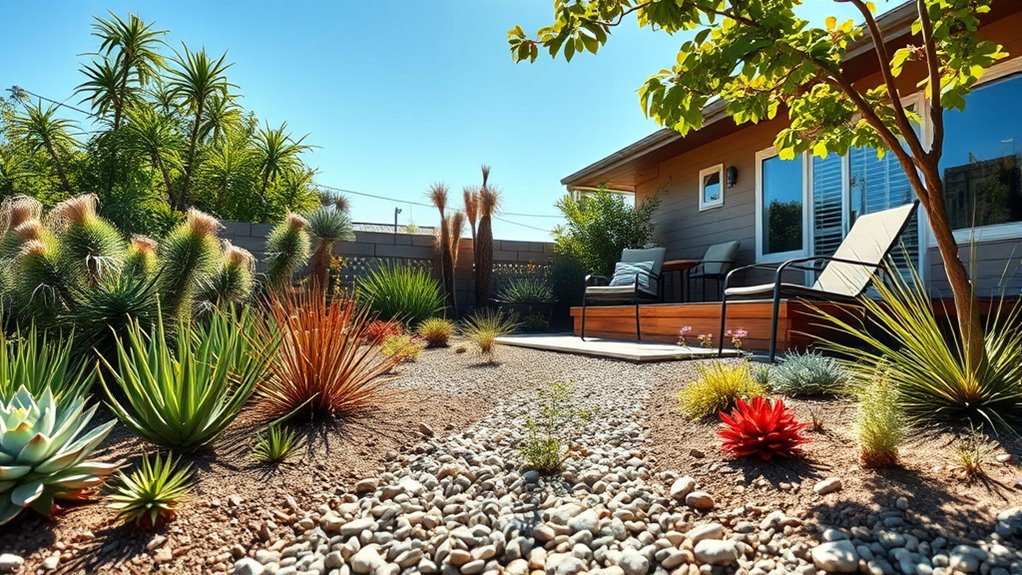
How can you choose the right plants for a low-maintenance backyard? Start by considering drought-tolerant plants like sedum and hardy abelia, which require less watering and minimal pruning.
Look for perennials such as hostas for shade and black-eyed Susans for vibrant flowers. Select plants adapted to your local climate and soil type to guarantee they thrive with less care. Incorporating educational toys into your gardening routine can also provide insights on how to effectively care for your plants. Additionally, consider adding chia seeds to your diet for their nutrient-dense properties, which can support your gardening endeavors by providing energy and improving overall health. Regularly assessing your garden and rotating plants can help maintain a thriving landscape with minimal effort. Engaging in physical activity while gardening can also enhance your overall well-being and energy levels.
Group similar plants together based on their watering needs and place them strategically to maximize natural conditions. Incorporate varieties like Dianthus for year-round floral interest and ground covers to reduce mowing. Additionally, consider the importance of routines in maintaining a low-maintenance garden, as a consistent care schedule can help keep your plants healthy with minimal effort.
Water Management
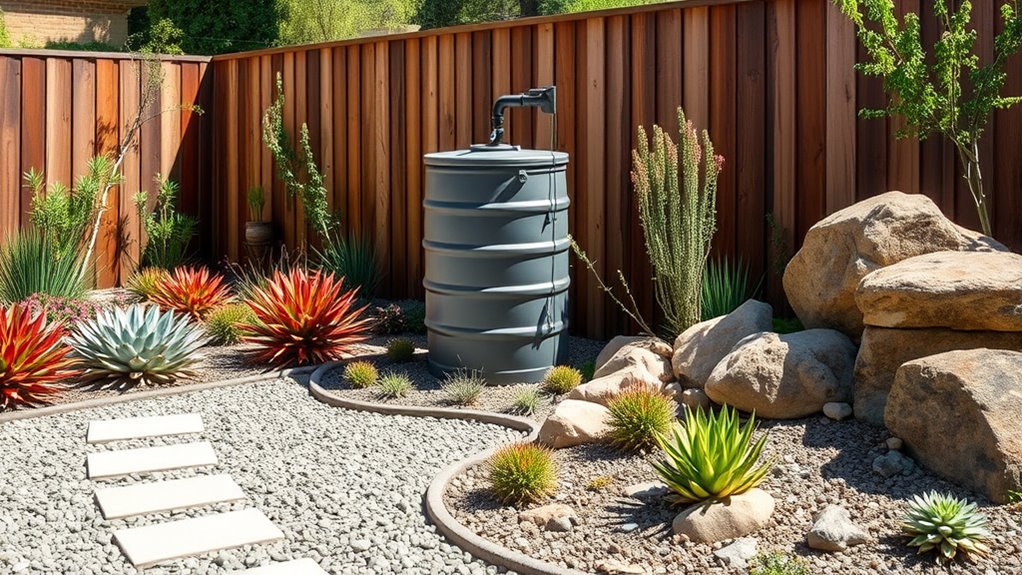
Effective water management is essential for maintaining a low-maintenance backyard, as it minimizes the need for constant upkeep while ensuring your plants thrive.
Start by installing efficient irrigation systems like drip irrigation to deliver water directly to your plants, reducing waste. Consider rainwater harvesting by collecting rainwater in barrels to cut down on municipal water use.
Install efficient irrigation systems and consider rainwater harvesting to minimize waste and reduce municipal water use.
Smart watering timers can automate your irrigation schedule, adapting to changing weather conditions. Use mulch to retain soil moisture and suppress weeds, while hydrozoning groups plants with similar water needs for peak efficiency. Additionally, using appropriate primer for your plants can significantly enhance their growth and resilience. Incorporating a water filtration system can also ensure that the water you use is safe and beneficial for your plants. Moreover, ensuring your irrigation system is well-maintained can contribute to optimal airflow and efficiency, similar to how geothermal systems require regular maintenance for optimal performance.
Implement rain gardens and permeable pavers to manage excess rainwater and enhance your landscape’s eco-friendliness, reducing the risk of flooding and erosion. Additionally, incorporating energy-efficient systems into your backyard design can further support sustainable practices and reduce overall resource consumption.
Decorative Elements
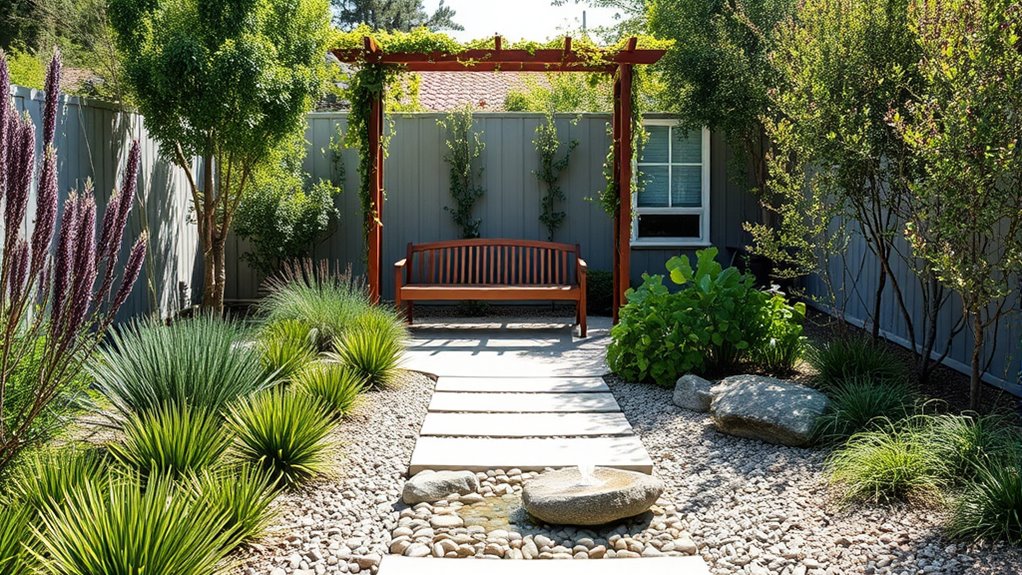
While creating a low-maintenance backyard, incorporating decorative elements can elevate your outdoor space without adding excessive upkeep.
Consider using gravel for pathways and patios; it’s affordable and versatile. Mulch, whether wood chips or recycled rubber, helps retain moisture and suppress weeds.
For visual interest, drought-tolerant plants like succulents or native plants are excellent choices that require little water. Additionally, incorporating drought-tolerant plants can reduce water usage and maintenance needs. You can add natural stone or boulders to enhance texture, and a stone patio is easy to clean for gatherings. Adding natural elements such as plants and rocks can create a balanced atmosphere in your outdoor space. Using holistic approaches can further promote sustainability in your backyard design. To further enhance your space’s ecosystem, consider introducing pollinator-friendly plants, which can also support local bee populations.
Incorporate solar-powered lighting for ambiance without the hassle of wiring. Finally, decorative benches or art pieces like mosaics can enhance your space while keeping maintenance minimal. By integrating natural elements like plants into your design, you can create a harmonious environment that complements your low-maintenance goals.
Embrace these elements for a beautiful, low-maintenance backyard!
Ecosystem Support
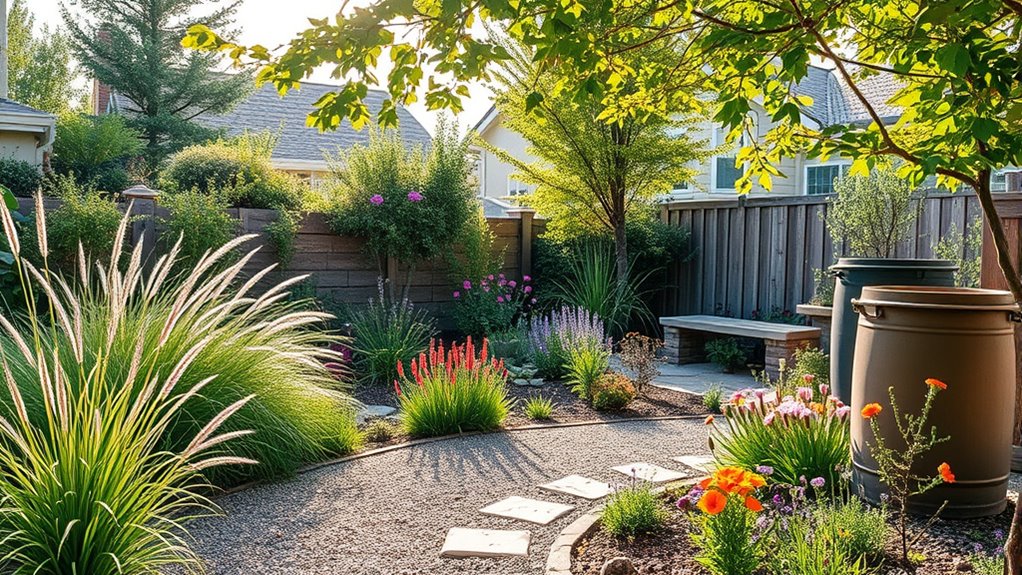
Creating a low-maintenance backyard goes hand in hand with supporting local ecosystems, making your outdoor space not just beautiful but also beneficial.
Start by choosing native plants that attract and sustain local wildlife, offering them food and shelter. Incorporate drought-tolerant varieties like Russian Sage and Globe Amaranth for water efficiency. A mix of flowering species will draw in pollinators, while ground cover plants reduce mowing and watering needs. Emotional intelligence in understanding the needs of your local wildlife can enhance your gardening decisions. Additionally, incorporating raw nutrition elements, such as a small vegetable garden, can provide fresh produce while supporting biodiversity. Consider implementing water conservation techniques, such as boiling water for purification, to ensure your plants thrive in a sustainable manner.
You might also consider adding small ponds or bird baths to provide water sources for wildlife. Constructing bee nests or wood piles creates habitats for beneficial insects and small creatures. Additionally, by planting native species, you enhance local biodiversity and support a thriving ecosystem in your backyard.
Maintenance Strategies
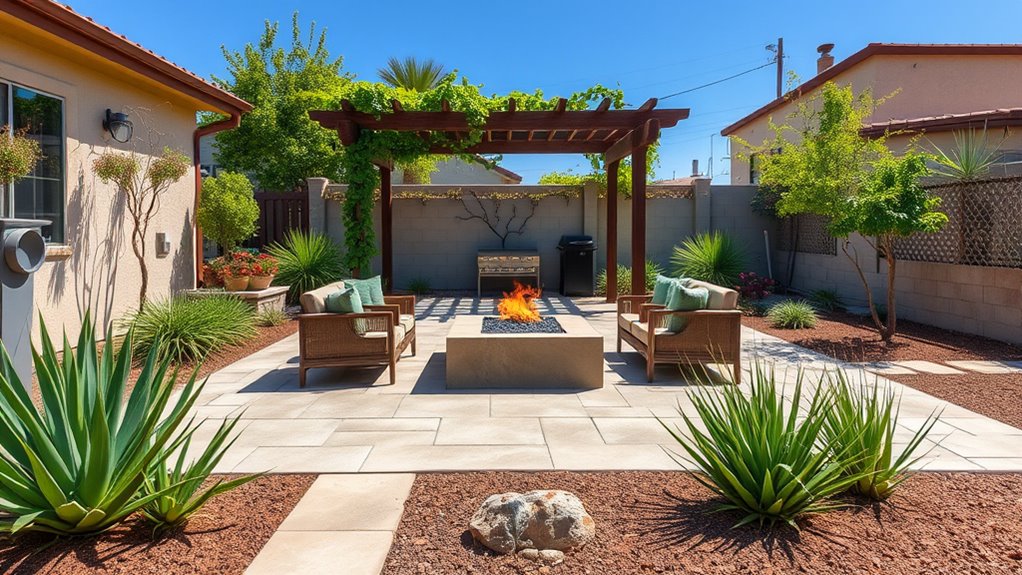
To keep your low-maintenance backyard thriving, it’s vital to implement smart maintenance strategies that minimize effort and maximize enjoyment.
Start by selecting native and drought-tolerant plants that require less water and care. Incorporate hardscaping features like patios and walkways to reduce lawn upkeep.
Choose native, drought-tolerant plants and add hardscaping features to simplify maintenance and enhance your backyard’s beauty.
Utilize efficient irrigation systems to automate watering and consider rainwater harvesting to lower costs. Regular soil analysis helps you choose the right plants, while mulching retains moisture and prevents weeds.
Schedule regular inspections and cyclical maintenance to catch issues early. Finally, use durable materials for outdoor features to guarantee long-lasting beauty without constant repair.
Frequently Asked Questions
How Much Upfront Cost Is Expected for a Low-Maintenance Backyard Design?
When planning for a low-maintenance backyard design, you can expect upfront costs to vary widely based on your choices.
Typically, you might spend anywhere from $5,000 to over $100,000, depending on materials and features.
For landscaping design alone, budget around $0.05 to $0.75 per square foot.
Installation costs generally range from $5 to $20 per square foot, so careful planning can help you manage your expenses effectively.
Can I Incorporate Lawn Areas in a Low-Maintenance Design?
You might think a low-maintenance design means saying goodbye to any lawn, but that’s not true!
You can definitely incorporate small lawn areas for aesthetics, balancing beauty and upkeep. Opt for drought-tolerant grass to minimize watering, and limit lawn size to reduce mowing.
Pair that with native plants and hardscaping features, and you’ll create a visually appealing space that requires less effort, allowing you to enjoy your yard without the constant work.
What Are the Best Materials for Hardscaping?
When considering the best materials for hardscaping, you’ll want to think about durability and aesthetics.
Natural stone and brick offer timeless appeal and weather resistance, while concrete pavers provide customization and easy maintenance.
Decomposed granite is great for pathways, and interlocking pavers enhance stability.
Make certain your materials suit your local climate and complement your design style, blending seamlessly with your greenery for an appealing outdoor space.
How Do I Choose the Right Location for My Garden Elements?
When you’re choosing the right location for your garden elements, start by evaluating sunlight patterns to match plants’ needs.
Check the soil quality and guarantee it drains well.
Make certain you have easy access to water for irrigation.
Consider nearby structures that might affect light and airflow.
Finally, think about visual appeal—select spots that enhance the beauty of your space while accommodating your gardening activities effectively.
What Tools Do I Need for Low-Maintenance Landscaping?
For low-maintenance landscaping, you’ll need a few essential tools.
Start with ergonomic hand tools like trowels and weeders to make planting and weeding easier on your hands. Pruners and loppers help you shape plants efficiently.
For yard upkeep, a leaf blower and string trimmer keep your space tidy.
Don’t forget a drip irrigation system for efficient watering.
These tools will simplify your tasks, allowing you to enjoy your outdoor space with minimal effort.
Conclusion
By designing a low-maintenance backyard, you’re not just saving time—you’re creating a personal oasis. Imagine sipping coffee on a Sunday morning, surrounded by vibrant plants that practically care for themselves. With smart water management and thoughtful decorative elements, your outdoor space becomes a stress-free retreat. Plus, supporting local ecosystems adds a layer of beauty you didn’t expect. So, as you relax, you’ll realize your low-maintenance haven is the perfect coincidence of nature and tranquility.


